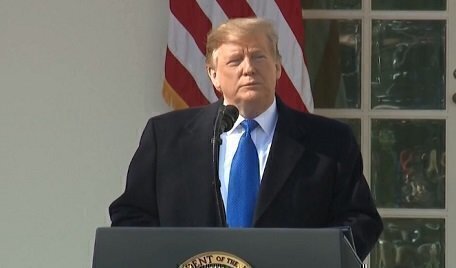On Friday morning, President Donald Trump said he would declare a national emergency to allocate more funds to expand walls or barriers at the United States-Mexico border. The emergency declaration may only apply to Defense Department funds already allocated by Congress, but a long legal fight appears to be on the horizon.
 As of late Friday morning, the national emergency declaration had not been signed and registered, and President Trump indicated it would be signed later in the day. But it was widely reported on Thursday evening that of the $8 billion projected to be spent for the wall or barrier project, $3.6 billion now would come from the Defense Department's construction budget under the national emergency declaration.
As of late Friday morning, the national emergency declaration had not been signed and registered, and President Trump indicated it would be signed later in the day. But it was widely reported on Thursday evening that of the $8 billion projected to be spent for the wall or barrier project, $3.6 billion now would come from the Defense Department's construction budget under the national emergency declaration.
The other funds would come from executive actions about funds already appropriated by Congress, including $2.5 billion in the Defense Department drug-interdiction budget. In addition, Congress has passed a budget bill that will appropriate $1.375 billion for a border construction project.
Trump has repeatedly said the border situation has elements of security concerns and a humanitarian crisis that require immediate executive action. Trump’s opponents and others believe the national emergency declaration violates the Constitution or raises significant questions about the constitutional relationship between the President and Congress.
At his announcement on Friday, President Trump said if legal actions are taken, as expected, he would get a “fair shake” at the Supreme Court and “happily we’ll win, I think.”
The fundamental question raised in this situation is about the President’s ability to use funds approved by Congress for purposes not specified by lawmakers. The Constitution’s Appropriations Clause gives Congress the general power of the purse. But the Constitution allows empowers the President to act in times of emergency.
In our Interactive Constitution, Yale Law’s Kate Stith explains this key issue involving presidential emergency powers.
“The Appropriations Clause would appear to categorically enjoin the President and federal agencies to spend funds only as appropriated by Congress. Even where the President believes that federal spending is urgently needed, spending in the absence of appropriations is constitutionally prohibited,” Stith writes. “Of course, where an emergency exists, a President may decide that principles more fundamental than the Constitution’s appropriations requirement justify spending. For instance, at the outbreak of the Civil War—with the Nation itself at risk—Lincoln ordered the expenditure of two million dollars in federal funds in advance of appropriations.”
The debate over executive powers in this area goes back to the time of English philosopher John Locke, who envisioned a need for emergency executive powers when legislative powers were lacking or unavailable. President George Washington used executive emergency powers to end the Whiskey Rebellion, and President Abraham Lincoln used emergency powers during the Civil War.
After the Vietnam and Watergate eras, Congress passed the National Emergencies Act in 1976 to better define the presidential ability to declare a national emergency. The act gave Congress a role in that process, with the option to end a national emergency declared by a President. The act also requires the President to cite which “statute for use in the event of an emergency shall be exercised unless and until the President specifies the provisions of law under which he proposes that he, or other officers will act.” Also, the President needs to show Congress where money is spent during an emergency. But the President retains the power to declare and then continue a national emergency with notice to Congress.
Prior to Trump’s announcement, Yale Law’s John Fabian Witt as cited two possible statutes that the White House could use in an executive order or proclamation. One was U.S. Code § 2293, which allows the Secretary of the Army in a national emergency to “apply the resources of the Department of the Army’s civil works program … [to] the construction, operation, maintenance, and repair of authorized civil works, military construction, and civil defense projects that are essential to the national defense.”
The other was U.S. Code § 2808, which allows the Defense Secretary during a national emergency to “undertake military construction projects … not otherwise authorized by law that are necessary to support such use of the armed forces. Such projects may be undertaken only within the total amount of funds that have been appropriated for military construction.”
The question of acquiring private real estate for a wall project is also critical, since two-thirds of the wall project's projected land belongs to private parties. The Supreme Court’s landmark decision in Youngstown Sheet & Tube Co. v. Sawyer (1952), when a divided Court blocked President Harry Truman from seizing privately owned steel mills during a national emergency, will undoubtedly be raised in any legal action attempting to block the national emergency order about the wall.
Also, the courts and especially the Supreme Court tend to defer to the President on national security matters. These and other trends and precedents will be raised in the various legal challenges expected to the national emergency declaration.
Scott Bomboy is the editor in chief of the National Constitution Center.







